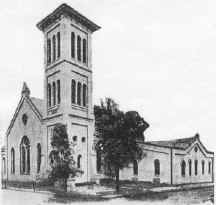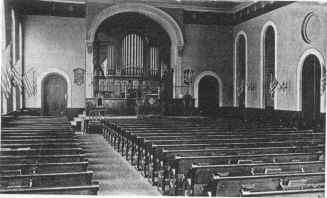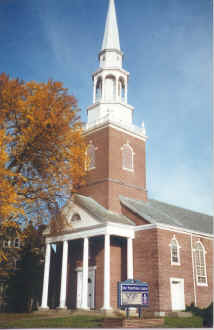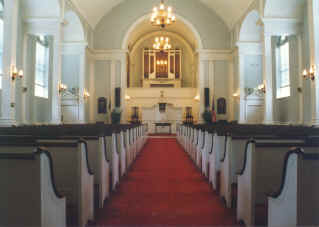| "Although the Presbyterians
were ... early spreading the tenets of their sect abroad in this State, it was not until
1850, they made their first efforts at Chester, under the auspices of the Rev. James W.
Dale. He preached in the Court House for over a year. In 1852, the First Presbyterian
Church, a fine brick building, mastic on the outside, situated at the S. E. corner of
Fourth and Welsh streets, was erected. Mr. Dale was succeeded by the Rev. J. O. Steadman
[Stedman], for two years. His successor for two years more, was Rev. George Van Wyck, and
in 1856, the Rev. Alexander W. Sproull became the first regular pastor. The present
incumbent, the Rev. Philip H. Mowry, was installed Dec. 11, 1873." Chester (and its
Vicinity,) Delaware County in PA – Published 1877 – John Hill Martin, Esq.
fully indexed by John A. Bullock III., Graphic
Details Publications
From the First Presbyterian Church 100th Anniversary
Booklet (1951)
by Fred Echelmeyer, Chester Times
A Century of Service
On November 3, 1851, on land donated by I. E. Cochran at
Fourth and Welsh Streets, the cornerstone of the Chester Presbyterian Church was laid, and
the congregation known today as the First Presbyterian Church began its century of devout
worship.
This local island of Presbyterianism in the city a century
ago appears to owe its origin to a fire, according to Chester F. Baker, a member of the
Delaware County Historical Society.
It is interesting to examine the growth of Presbyterianism
in old Chester County, now made up of Chester and Delaware Counties. Presbyterianism
had crept northward from Maryland and Delaware into Pennsylvania, first finding a stopping
place south of Chadds Ford near the east bank of the Brandywine in Birmingham Township.
By 1716, Presbyterians in western Chester County belonged
to the New Castle, Del., Presbytery, but in 1720 the first church to be established within
what is now Delaware County was started as the Lower Brandywine Presbyterian Church.
It was erected on land purchased from Ralph Pyle of Concord, and the lot embraced
81 perches of land which Pyle conveyed to eight trustees for the amazingly small sum of
five shillings. The church was a log building, with the usual burying ground
attached. This ancient structure existed until 1773 and the last burial in the
graveyard is recorded in 1820.
Dr. George Smith, in his "History of Delaware
County," states that there were other attempts to organize Presbyterian churches,
notably in Newtown Township, and prior to this time, but if so, the meetings were held in
the homes of a few worshippers.
Lower Brandywine was too small and too poor to support its
own minister except for short periods of time commencing in 1730 and in 1769. For
the most part it depended on stated Sundays by uniting at times with White Clay Creek
Church in Delaware and with Middletown Church in what is now Delaware County.
The congregation was split by dissension in 1773, when the
majority voted for uniting with the First Church of Wilmington. This led the next
year to the removal of Lower Brandywine Presbyterian Church west of the Brandywine into
Delaware. The records are then silent on the fate of this old church, but it is
reported a visitor to the old site may still see traces of the abandoned graveyard.
Living quickened in old Chester County in the years after
the Revolutionary War and the establishment of the nation, and by 1840 the Presbyterians
of Chester were traveling several miles each way on Sundays to services at the old Leiper
or Ridley Church in Ridley Township or to the Middletown Presbyterian Church.
As Mr. Baker recalls, our ancestors were accustomed to
travel long distances for Sunday services. Although Middletown Presbyterian Church
was not the oldest congregation in the county as has sometimes been said, there were many
residents of what is now lower Delaware County who made the Sunday jaunt to the county
church.
This long journey has not failed to make its mark
geographically. Where the Mt. Alverno Bridge crosses Chester Creek near Rockdale is
a shallow place still known as Presbyterian Ford. The ford is located on the north
side of the bridge. Chester residents traveled to Middletown Presbyterian Church,
and buried their dead there, although after the establishment of Chester Rural Cemetery in 1863 many of the Presbyterians of
Chester removed their dead from Middletown.
Many other Chester Presbyterians journeyed to the Ridley
or Leiper Church across Ridley Creek. At that time, dating back to May 17, 1846, the
Reverend James W. Dale was pastor of both the Middletown and Ridley congregations.
In November of that year, the twenty-second to be exact,
Middletown reopened after being rebuilt that summer. The rededication took place at
10 a.m. that Sunday morning, and congregations from Mt. Gilead and Ridley were present to
hear Dr. Dale preach the sermon.
Then tragedy struck in the form of fire. A blaze
attributed to an overheated stove pipe in the Presbyterian Church at Ridley totally
destroyed the church building on January 28, 1849.
Looking about for a temporary place in which to hold
services, the pastor was asked to consider the court house
in Chester. This historic old public building had hit on sorry times.
There was a great discussion which eventually resulted in the removal of the county seat
from this ancient shire town to a new town called Media out beyond the Middletown
Presbyterian Church several years later.
The congregation settled down to their temporary place of
worship after Dr. Dale gave his first sermon on March 18, 1849. Meanwhile, plans
were made to rebuild the Ridley Church and the cornerstone was laid on Monday morning,
June 17, 1850.
On August 16, 1850, the Presbyterian worshippers got in on
the early formation of Media, and at the suggestion of Dr. Dale a drive was started that
netted $4,000 to build a temperance house in the newly-chartered borough. The
building was to cost no less than $5,000 and was to be called the Charter House.
Part of this building, its use altered, still stands today.
Dr. Dale was back in Chester preaching on November 17,
1850, after a tour of ministerial duties at Crookton, or Crookville, now Sackville, in
Nether Providence Township. On December 12, 1850 the Presbyterians wondered about
the fate of their temporary church meeting house, as the old court house was offered to
public sale.
It would appear that as soon as the Ridley Church
parishioners could rebuild their church they would leave Chester, but this was not the
case. It had become exceedingly convenient to get to church in the central part of
the city and not several miles out in the country. The parishioners wanted a church
near at hand.
One of those who felt in this manner was I. E. Cochran,
and he proposed to do something about it. He gave the congregation a lot from a
section of land taken by him in partition of his father's (John Cochran's) estate at the
southeast corner of Fourth and Welsh Streets. Mr. Cochran and Joseph H. Hinkson gave
handsomely from their own funds to build a new Presbyterian Church in Chester.
On September 12, 1851 Mr. Hinkson received bids for
building the church, and at 3 p.m. on November 3, the cornerstone was laid.
Steady progress marked the founding of the Chester Church.
Dr. Dale was still riding the circuit, for we know from the files of the Delaware
County Republican that the pastor was preaching on November 16, 1851 at Mount Gilead
Church, now no longer existent, which was located northwest of Aston Mills.
On Sunday, July 18, 1852 the new church was dedicated,
with the Reverend Jones of Philadelphia preaching the dedicatory sermon.
During that day more than $1,000 was subscribed by the
worshippers. The new church called the Reverend James O. Stedman, formerly of
Wilmington, N.C., to the pulpit. He remained until April 28, 1854 when he left for
another pulpit, this one at the First Church of Memphis, Tenn. The change was
brought about by the death of Mrs. Stedman.
By June 11, the Chester church had a new pastor, the
Reverend George P. Van Wyck, who on this day preached his first sermon.
In two years' time the church had another pastor, the
Reverend Alexander W. Sproull. The new minister preached his first sermon on July
13, 1856. While Mr. Sproull went about his pastoral duties, spreading the gospel in
the county, and addressing meetings around the fringes of what is now known as the city of
Chester, the church folk decided the building needed a tower, and on September 16, 1856,
the tower was completed. It was on the same day this announcement was made that Mr.
Sproull was formally installed as pastor.
Ten days later the congregation was thrilled.
Illuminating gas was brought into the building. The frugal church fathers announced
the sale of four pulpit and eight hanging lamps for burning lard oil.
That old church which had only 17 members when formally
organized in 1853, with a Sunday School of 30, marched steadily ahead with Robert Benedict
as ruling elder. The church soon became too small for the congregation. In
October, 1860 the parishioners trooped back to the Court House while extensive renovations
were made.
On January 27, 1861, the Chester Presbyterian Church was
re-dedicated, after renovating and enlarging at a cost of $5,000. There was now room
for 600 persons in the auditorium which measured 80 by 38 1/2 feet. Behind the
pulpit, and raised about 18 inches, was a choir gallery facing the congregation. On
each side of this room was a smaller room, one for the pastor and the other an entrance to
the basement Sabbath School room and the choir gallery.
The ceiling was flat, and divided into seven panels.
The side walls were blocked to imitate stone. Three large painted glass
windows ornamented the front. This beautiful building is now the location of
Cornwall's Garage at Fourth (formerly Clinton) and Welsh Streets. Part of its
pre-Civil War grandeur may still be caught today.
The congregation was shocked in April when Joseph H.
Hinkson, one of the founders of the church, was killed on the Philadelphia, Wilmington and
Baltimore (now the PRR) Railroad at Welsh Street. This gentleman was the grandfather
of the late John Caldwell Hinkson, and great-grandfather of J. H. Ward Hinkson,
widely-known Chester attorney. On April 25, 1864 a meeting was held to pay respects
to this founder of the church.
Apparently the renovations of 1861 did not include the
tower, for it was not until December 14, 1866 that mention is made of the completion of
the structure. A parsonage then was constructed in the old South Ward (west of
Chester River) in 1869 through the generosity of Thomas Reaney.
On April 29, 1870 the new church organ arrived. It
had 24 stops and nearly 1,000 pipes, being at that time the largest or at least one of the
largest in Delaware County. It cost $2500, and on May 5 it was officially dedicated
to the ministry of music by Professor Harry E. Thunder of Philadelphia, who presented a
concert at the time.
On December 8, 1871 a new Presbyterian chapel was underway
on Upland Street just south of Twelfth Street. This brick edifice became first the Third Presbyterian Church and today it is the Siloam Methodist
Church.
On April 2, 1873, the Reverend A. W. Sproull resigned and
left for a church at Sag Harbor, Long Island, and on July 4, the Reverend George F.
Robinson, a graduate of Princeton Theological Seminary, was chosen to fill the pulpit.
It is interesting to note that right in this period the name Chester Presbyterian
Church was dropped for the title used today, the First Presbyterian Church.
Apparently Mr. Robinson was unable to accept the call, for on September 19 the church
extended a call to the Reverend Phillip H. Mowry of Springfield, Ohio, who consented to
take charge. He was to receive a salary of $2,600, and joined a congregation that
had just completed a new lecture room which was to be used for Sunday School purposes.
Dr. Mowry was installed as pastor on December 11, and
moved in at 225 E. Fifth Street. Shortly after the arrival of Dr. Mowry, who did
much for First Presbyterian Church, there came the death of the real organizer of the
church, Mr. Dale on April 19, 1881. The church folk did not forget this stern
advocate of temperance, learned in law as well as the Gospel, and on September 30, 1884,
R. Rawnsley of Chester received a contract to erect a monument in his memory.
Dr. Mowry served the growing parish well and relinquished
his duties in 1916 after 43 years of service that endeared him to his parishioners and his
community as well. Mowry Street in the First Ward is named for this eminent
clergyman. He continued to live in Chester as pastor emeritus until his death in
1920. He was succeeded as pastor of the First Church by the Reverend William R.
Houston.
The movement of the residential population uptown affected
the First Presbyterian Church, and a new location at 23rd Street and Edgmont Avenue was
decided upon. The new edifice was modeled along the beautiful lines of typical New
England places of worship. Clarence Wilson
Brazer, who maintained his architectural
offices in the Crozer Building (now of New York City), was selected to plan the church.
Members of the Session of 1922 all are now deceased.
Lee P. Wray, a consulting engineer of Swarthmore, former administrator of the
Chester Hospital, and Harry G. Innis are among the few trustees who survive. Ground
was broken for the new church on March 8, 1920, and the cornerstone was laid on October
30, 1921. Cost of the building, exclusive of land, was approximately $100,000.
While the Chester School District was building Wetherill
School the first public kindergarten class ever conducted in the city was held in a
temporary frame chapel which had been built on 23rd Street off Edgmont Avenue. After
1922, this chapel was used as a Sunday School, the primary department being conducted in
one of the rear rooms of the church building. For many years the neighborhood
children assembled in this old frame chapel to see motion pictures on Friday evenings, but
it was condemned as a fire hazard and eventually removed.
A bright young man, the Reverend William Barrow Pugh took
over the pulpit in 1929, and through his life and activities spread the name of the First
Presbyterian Church around the globe. A forceful, informed organizer, Dr. Pugh was
for years associated with the General Assembly of the Presbyterian Church of the United
States as an assistant to the stated clerk. He continued his local duties until 1938
when he stepped into the position of stated clerk, and proved to be one of the most
effective Presbyterian officials in church history.
Dr. Pugh was appointed by the United States Government to
inspect the manner and quality of religious instruction in the armed forces of the country
during World War II, and afterward he was largely instrumental in gathering together many
large Protestant denominations into a unified group, working toward global union of
Protestant faiths.
This great work was tragically stopped when an automobile
accident on a mountain side near Thermopolis, Wyoming, in September, 1950, snuffed out his
life. As usual, he was "about his Father's business."
When Dr. Pugh was appointed stated clerk of the General
Assembly in 1938, the congregation called the Reverend John David Lindsay, of Findlay,
Ohio, to the pulpit. The Reverend Lindsay very quickly integrated himself into the
church and the community, as did his wife, his two sons and daughter. It was not
long before he was prominently known throughout the area and there were few civic
undertakings which did not find him in the forefront.
The Reverend Lindsay was particularly fond of young people
and well knew that the future of the church was dependent on the youth of the day. A
drive for funds was started to build a new Sunday School building which would attract
young people to the church and replace the old frame building which had become entirely
unsuited and, in fact, unsafe. Under his leadership this project was successfully
concluded, and ground was broken on December 10, 1941, for the present beautiful building,
matching the church proper in architecture. The cornerstone of the building was laid
on July 12, 1942. Frank J. Kerr was the builder and the architect was Norman Hulme.
This building will be formally dedicated as Lindsay Hall
on the one hundredth anniversary of the church on November 3 in memory of the Reverend
Lindsay who passed away on February 6, 1951, following an illness of several months.
During the Reverend Lindsay's illness, and until September
9 of this year, when the church was without a pastor, the pulpit was effectively filled by
the Reverend Hubert Broyles who did magnificent work in tiding the church over such a
difficult time.
Meanwhile, a pastoral committee appointed by the
congregation was busy seeking and interviewing candidates for the pastorate of the church.
After traveling hundreds of miles, and listening to and interviewing many possible
candidates, they reported back to the congregation that they had found a truly outstanding
young minister, the Reverend Roger A. Huber. On the basis of the committee's
recommendations, and the Reverend Huber's candidating sermon, the congregation called him
to the pulpit on September 9.
In the short time ensuing he has done a truly remarkable
job of leadership and he and Mrs. Huber have already endeared themselves to the members of
the congregation.
Thus, through the century, the First Presbyterian Church,
marching along hand in hand with Divine Providence, has grown and still grows in strength,
fed by the devotion of its ministers and its congregation.
Today, under the inspiring leadership of the Reverend
Roger Huber, it is surging ahead spiritually in eager anticipation of still greater
service to Christ and the community.
During the 1980's,
the congregation of Chester's Third Presbyterian Church merged
with this congregation.
* Important Notice - February
26, 2002 *
The congregation of First Presbyterian Church
of Chester voted to dissolve our church as of April 7, 2002. This was done with much
prayer, thought, discussion, and sadness. However, with an ever declining and aging
congregation we felt we had no alternative.
After April 7th, The Way Through Christ Ministry will
be holding services at the church.
|



